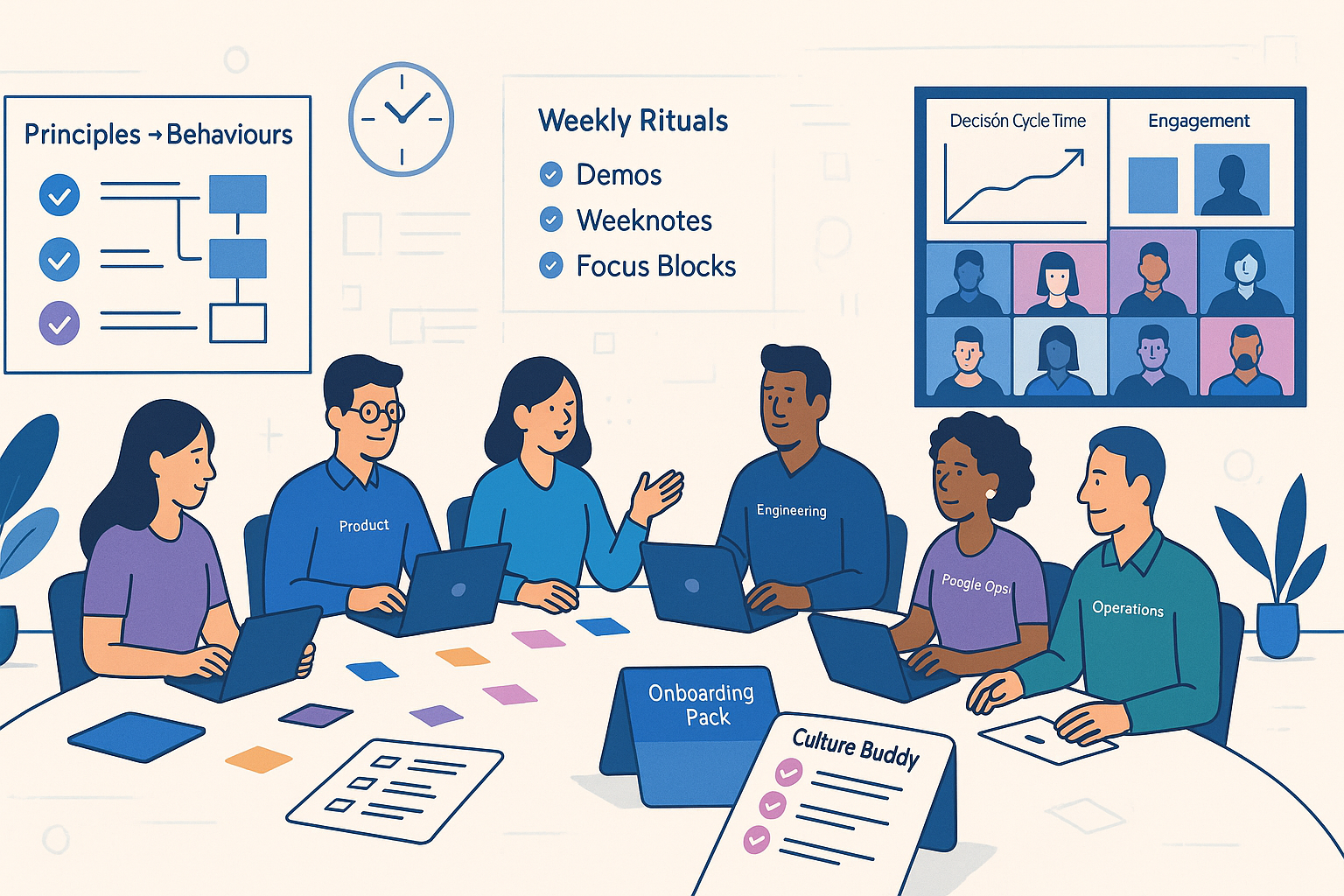
Keep Culture Strong as You Scale: A Guide for Leaders
Introduction
Growth exposes culture. It does not create it. If your culture is vague, undocumented or leader-dependent, scale will dilute it. If your culture is clear, embedded in how work actually gets done and reinforced by mechanisms, scale will strengthen it. This guide is for leaders who want the latter. The aim is simple: keep culture strong as you scale.
The brutal truth about culture at scale
Culture is not posters or perks. It is the default behaviour when leaders are absent and pressure is high. At scale, that default is either designed or accidental. Accidental culture always trends to bureaucracy, confusion and inconsistency. Designed culture trends to clarity, speed and ownership. Decide which future you want, then build the system that makes it likely.
A simple lens for the big picture
At PerformanceNinja we look at culture through a systems lens. Purpose, People, Proposition, Process, Productivity and Potential must align or you will get cultural friction. Do not attempt to scale culture through slogans. Scale it by aligning these parts so behaviour and outcomes are mutually reinforcing.
Diagnose your culture before you accelerate
Before you add people, products or geographies, establish a baseline. You are about to amplify whatever currently exists.
- Run a culture mapping sprint. Capture the lived behaviours that create success and those that undermine it. Use real examples from the last 90 days.
- Identify non-negotiables. Name the few behaviours you will defend, even when it costs in the short term.
- Surface cultural debt. List unhelpful norms that were useful early but now create drag.
- Trace decision bottlenecks. Map where decisions stall, why they stall and who owns them.
- Quantify friction. Measure handoff failures, rework, missed deadlines and avoidable escalations.
Harden your definitions: codify without killing autonomy
Culture thrives when the core is non-negotiable and the edges allow local judgement. Codify the core as a Culture Operating System.
- Principles: Memorable rules of thumb that guide trade-offs. Example: closest to the customer decides.
- Behaviours: Observable actions that prove the principles. Example: product reviews include a customer artefact every time.
- Decision rights: Clear owners, inputs and escalation paths. Example: disagree-and-commit within 48 hours.
- Rituals: Repeated events that create rhythm. Example: weekly demo day that showcases learning, not just wins.
- Symbols: Visible cues that signal what matters. Example: leaders share their own failure logs monthly.
- Stories: Short narratives of real people living the behaviours. Curate a story bank and retell them often.
- Guardrails: Red lines that protect standards. Example: no critical decision without pre-read and documented rationale.
Wire culture into work, not wallpaper
Posters do nothing if your systems contradict them. Embed culture into the operating model so that doing the right thing is also the easiest thing.
Decision-making
- Define a single decision taxonomy: propose, review, decide, record, share.
- Use decision records for all material choices. One page, one owner, timestamped, searchable.
- Mandate pre-reads 24 hours before meetings. No slides created during the meeting.
- Track cycle time for decisions by type. Shorten it deliberately.
Hiring and onboarding
- Design hiring scorecards that test behaviours, not just skills. Invite a cross-functional panel to reduce local bias.
- Add a culture scenario interview. Present a real dilemma from your environment and evaluate judgement.
- Onboarding must teach how the system works. Include decision rights, ritual cadence and examples of trade-offs.
- Assign a culture buddy. 30 minutes a week for the first 8 weeks to decode norms and language.
Performance and promotion
- Convert values into graded behavioural anchors. Make them unambiguous and observable.
- Review work artefacts to assess behaviours, not opinions.
- Promotion requires evidence of modelling culture under pressure. Give examples, not adjectives.
Ways of working and meetings
- Publish a meeting charter. Define when to meet, when to write and when to async.
- Use written briefs for problem-solving. Writing clarifies thought, accelerates alignment and documents decisions.
- Standardise a demo-first habit. Teams show the current state of work every week.
- Protect maker time. Institute team-wide focus blocks and enforce them.
Build mechanisms that scale the culture signal
As you grow, signal decays. Replace hallway folklore with deliberate transmission.
- Leadership shadow audits. Quarterly review of how leaders actually behave. Share results and actions.
- Story bank and narrative reviews. Keep 20 live stories that prove your principles. Leaders retell them weekly.
- Field loops. Rotate leaders into frontline work each quarter. Publish what changed because of the visit.
- Weeknotes. Short, public updates from teams. Focus on decisions, lessons and risks, not theatre.
- Open office hours. Fixed times where anyone can ask questions. Summarise insights and close loops.
Arm your managers: the culture transmission layer
Middle managers are your most important culture channel. Enable them with tools, clarity and air cover.
- A manager enablement kit. Conversation guides, decision rights map, escalation protocol and a behavioural scoring rubric.
- A conflict playbook. How to mediate values collisions quickly and fairly.
- Coaching on feedback that changes behaviour. Use situation, behaviour, impact, request.
- Clear authority. Define where managers can decide without approval. Remove ambiguity.
- Peer forums. Monthly manager roundtables to share patterns and standardise responses.
Prevent bureaucracy creep
Bureaucracy grows in the gaps between unclear ownership, misaligned incentives and fear. Attack it systematically.
- One-page process limits. No core process should require more than one page to explain. If it does, simplify.
- Kill zombie approvals. Catalogue every approval. Remove those that exist only because a mistake once happened.
- Shorten queues. Visualise work in progress. Limit batch sizes to reduce wait time and blame games.
- Automate compliance where possible. Human checks should focus on judgement, not form-filling.
- Measure administrative load. Track hours spent on non-value work. Set targets to reduce it quarterly.
Design for distributed and hybrid teams
Distance amplifies ambiguity. You will not keep culture strong by hoping remote reality behaves like co-located reality.
- Write more. Replace verbal tradition with searchable artefacts. Invest in a knowledge base with ownership and review cycles.
- Codify response time expectations. Define what is urgent, important and routine, and where each lives.
- Use persistent rooms for live work. Decision records, briefs and demos should live in channels where anyone can find them.
- Recreate proximity with purposeful pairing. Rotate pairs across functions to spread judgement and relationships.
- Make video optional, clarity mandatory. Focus on outcomes, not performative presence.
Measure culture like a product
If you do not measure it, you will manage it by feel. Measure leading and lagging indicators, both qualitative and quantitative.
Leading indicators
- Decision cycle time and rework rate.
- Percentage of meetings with pre-reads and decision records.
- Onboarding time to autonomous contribution.
- Frequency of demos, weeknotes and story retells.
- Manager enablement adoption: kits issued, sessions run, issues resolved at the right level.
Lagging indicators
- Engagement and intent to stay by critical segment.
- Internal mobility and promotion rates mapped to behavioural anchors.
- Customer NPS or equivalent, tied to specific behaviours.
- Quality outcomes: defects, escalations and post-incident learning quality.
- Speed to market for key bets without quality drop.
Instrument it all:
- Build a simple culture dashboard. 10 metrics maximum. Review monthly.
- Run quarterly pulse surveys with three consistent questions tied to behaviours.
- Add a culture section to post-mortems. What behaviour helped or hurt the outcome.
- Publish actions taken from insights. Close the loop visibly.
Case vignettes: what strong looks like in practice
- Product scale-up, 150 to 600 people: Reduced decision time by 40 percent by instituting one-page decision records and a 48-hour disagree-and-commit rule. Cultural outcome: faster, fewer escalations, clearer ownership.
- Professional services firm, 90 to 220 people: Converted values into behavioural anchors and integrated them into promotion criteria. Cultural outcome: reduced politics, clearer expectations, stronger managers.
- Marketplace company, 300 to 900 people: Replaced status meetings with weekly demos and written briefs. Cultural outcome: higher signal, less theatre, improved cross-team trust.
90-day action plan to keep culture strong as you scale
Days 1 to 30: assess and stabilise
- Run a culture mapping sprint. Document principles, behaviours and debt.
- Define 5 non-negotiable behaviours with examples.
- Design the first version of your Culture OS with principles, behaviours and decision rights.
- Launch decision records for material decisions. Track cycle time.
- Audit approvals and kill three zombie approvals.
Days 31 to 60: embed and enable
- Add behavioural anchors to performance reviews. Train managers.
- Introduce a written brief template for material problems.
- Launch weekly demos and weeknotes. Keep it lightweight, consistent and mandatory.
- Build the manager enablement kit. Hold the first manager forum.
- Publish your meeting charter. Protect focus blocks.
Days 61 to 90: scale and measure
- Stand up a culture dashboard with 10 metrics. Review monthly.
- Run the first pulse survey tied to behaviours. Share actions.
- Launch the story bank. Start every all-hands with one real story.
- Formalise onboarding with a culture buddy and decision rights training.
- Do a leadership shadow audit. Share what will change because of it.
Tough trade-offs you must make
- Hire slower or pay later. If you compromise on behaviours now, you will spend years unwinding the damage.
- Cut processes that create safety theatre. Replace with targeted controls backed by judgement.
- Reduce founder dependency. Push decisions down. Coach, do not rescue.
- Publish inconvenient metrics. If reality is bad, expose it and improve it.
- Remove high performers who poison the culture. Protect standards over short-term output.
Frequently asked questions
Q: Can we keep culture intact as we triple headcount?
A: No. Culture will change. Your job is to keep the core non-negotiables stable while evolving the rest. Codify the core and design mechanisms to transmit it.
Q: How much process is too much?
A: When the process exists to compensate for weak behaviour rather than to enable good behaviour. Test by measuring friction and outcomes. Remove steps that do not change either.
Q: What if managers are the weak link?
A: Treat manager capability as a product. Define the behaviours, build enablement, measure adoption, coach hard and change the people if needed.
Q: How do we avoid culture becoming performative?
A: Prioritise artefacts over announcements. Demos over speeches. Decisions over slogans. Evidence over opinions.
Q: Where should we start if we are already in chaos?
A: Start with decision rights, weekly demos and written briefs. These three moves create immediate clarity and reduce noise.
Common failure patterns to avoid
- Values without behaviours. Nobody knows what to do on Tuesday.
- Trying to change everything at once. Pick a few high-leverage mechanisms and build momentum.
- Delegating culture to HR. Culture is an operating issue for every leader.
- Treating remote as an afterthought. Design for distributed by default.
- Rewarding output that violates your principles. You teach what you tolerate.
Leaders: model the culture you want
Culture follows the leader’s shadow. How you decide, what you praise, what you tolerate and where you spend time will set the ceiling. Publish your own commitments. Invite scrutiny. When you make a trade-off, explain it. When you miss the mark, say so and correct quickly. Consistency compounds.
Final word: make culture a system, not a slogan
To keep culture strong as you scale, stop treating it as an initiative. Treat it as a system that powers performance. Codify non-negotiables. Wire them into decisions, hiring, onboarding, performance and meetings. Build transmission mechanisms. Arm managers. Measure relentlessly. Remove theatre. If you do this, growth will not dilute your culture. It will amplify it.
Next Steps
Want to learn more? Check out these articles:
Lead Like Special Ops: A Tactical Guide for Civilian Leaders
Measuring Organisational Health Beyond Engagement Scores
Reducing Friction in Team Workflows: Streamline for Success
To find out how PerformanceNinja could help you, book a free strategy call or take a look at our Performance Intelligence Leadership Development Programme.




